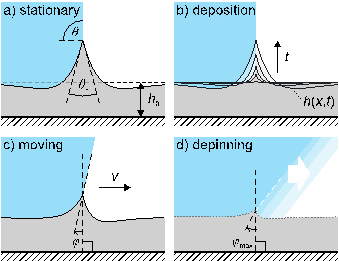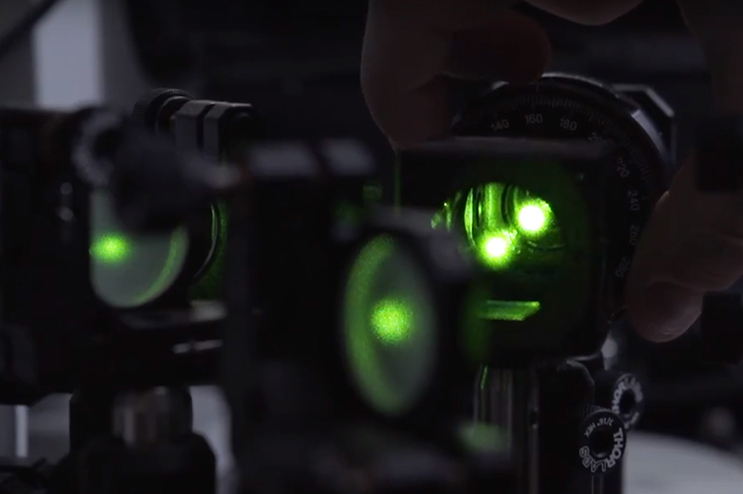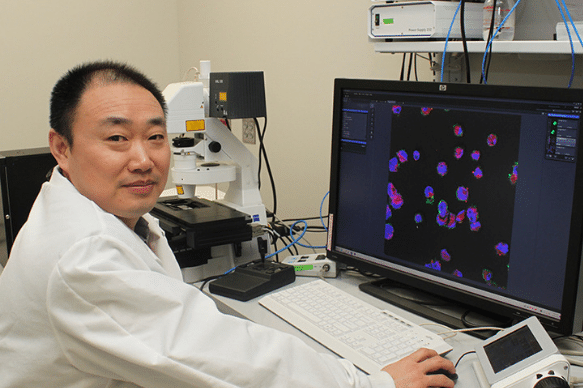News Story
Surfing Liquid Drops Shed New Light in Soft Materials Research
A collaboration between Mechanical Engineering Assistant Professor Siddhartha Das and researchers at the University of Twente in the Netherlands and ESPCI Paris, France sheds new light on how liquid drops behave on soft, squishy materials. The research, published in Nature Communications, could provide new insights into applications ranging from cancer therapies and contact lenses to 3-D printing and mayonnaise.
Understanding drop motion on different surfaces is a central question in fluid mechanics of capillarity and wetting. The motion of liquid drops on rigid surfaces has been well understood for several decades, but very little is known about the science of drop motion on a soft surface, like a jelly.
The team's study discovered that liquids placed on soft surfaces create tiny 'ridges' on the material at the edge of the droplet as a result of the droplet's surface tension. Surface tension is what gives a droplet its spherical shape or allows insects to stride over water.
Video courtesy of Dr. Stefan Karpitschka, University of Twente.
"When a drop rests or moves on a surface, this surface tension exerts force on the underlying material," Das explains. "For standard hard solids, like a glass slide, this force is too weak to cause any deformation to the solid. However, when the underlying material is very soft, like a gel, it forms these ridges at the solid-liquid contact line."

FIG. 1: (a) Drop-induced ridge formation on the soft solid (shown in gray); (b) Time-evolution for the growth of the ridge; (c) The ridge under the moving contact line; (d) The ridge after the drop has “left” the ridge. |
This ridge is present regardless of whether or not the drop is at rest or in motion. But, when the drop is in motion, the ridge and the soft solid underneath creates resistance in the form of friction, affecting the motion of the drop. This resistance is often more important than the internal friction within the liquid, and it dictates the drop's motion.
The present study develops experiment and theory to unravel the combined behavior of the ridge and the drop motion for different drop velocities. The drops are found to move by “surfing” this ridge
According to Das and his collaborators, their research is central to better understanding a large number of engineering applications, but Das believes the greatest implications could be in the areas of bio-physical and pathological research, especially for cancer therapies.
"Cancer cells show different spreading behaviors on rigid and soft surfaces in vitro," Das explains. "The present study will help evaluate whether this difference in the spreading behaviors can be successfully utilized to arrest the spread of cancer cells in vivo."
Another example Das cites is angiogenesis. Angiogenesis is the formation of new blood vessels from existing ones. It is one of central steps associated with a tumour transforming from being benign to malignant. A key step in angiogenesis is the motion of endothelial cells on the inner lining of blood vessel walls. This movement enables the cells to stack up for the sprouting of new blood vessels to “feed” the tumor.
"If we can improve our understanding of how these endothelial cells move in the inner lining of the blood vessel wall, this could potentially lead to the discovery of new drug therapies that could regulate this type of cell motion," Das said.
While its cancer-related potential provides for some of the most intriguing applications, the team's work could also help improve a number of other areas that involve liquid/soft solid interactions.
The team indicates that their research could improve things such as 3-D printing by providing a better understanding of the mechanism that involves the interactions of the molten materials in form of droplets with the partially solidified material. Their work also provides important cues that could lead to more reliable manufacturing of things such as soft contact lenses, mayonnaise and nano-structures on microchips.
The team's work, 'Droplets move over viscoelastic substrates by surfing a ridge,' was published in the journal Nature Communications on August 4, 2015.
Karpitschka, S. et al. Droplets move over viscoelastic substrates by surfing a ridge. Nat. Commun. 6:7891 doi: 10.1038/ncomms8891 (2015).
Published August 3, 2015









